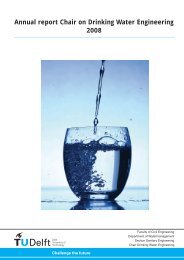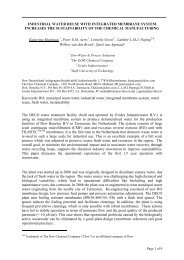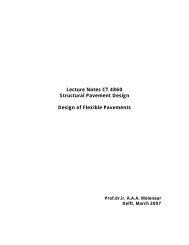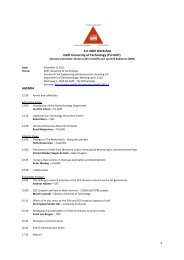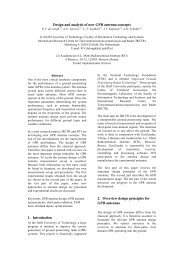CHAPTER 5 CONCRETE PAVEMENTS - TU Delft
CHAPTER 5 CONCRETE PAVEMENTS - TU Delft
CHAPTER 5 CONCRETE PAVEMENTS - TU Delft
You also want an ePaper? Increase the reach of your titles
YUMPU automatically turns print PDFs into web optimized ePapers that Google loves.
5.1 Introduction:<br />
Concrete pavements always require technical provisions to prevent uncontrolled<br />
cracking due to hardening shrinkage of the concrete and due to a decrease of the<br />
temperature. The possible measures are:<br />
- in plain (unreinforced) concrete pavements every 3 to 6 m a transverse joint is<br />
made, and in wide pavements also longitudinal joints are made; this means that<br />
the pavement is divided into concrete slabs<br />
- in reinforced concrete pavements such an amount of reinforcement (0.6 to 0.75%)<br />
is applied, that every 1.5 to 3 m a very narrow crack appears<br />
- in prestressed concrete pavements by prestressing such compressive stresses<br />
are introduced that the resulting flexural tensile stresses in the concrete due to<br />
shrinkage, prestressing, temperature and traffic loadings stay within acceptable<br />
values.<br />
The application of the ‘zero-maintenance’ but very expensive prestressed concrete<br />
pavements is limited to extremely heavily loaded pavements, especially airport<br />
platforms (for instance at Amsterdam Airport Schiphol). Reinforced concrete<br />
pavements, with a noise-reducing and permeable wearing course of porous asphalt<br />
(‘ZOAB’), are nowadays sometimes applied on Dutch motorways. In all other cases,<br />
however, plain concrete pavements are applied and for that reason in this lecture<br />
note only attention is paid to this type of concrete pavement.<br />
More extensive information about the design (and construction) of concrete<br />
pavements can be found in (1,2,3,4,5).<br />
5.2 Structure of plain concrete pavements:<br />
5.2.1 General:<br />
Figure 5.1 shows in general terms the plain concrete pavement structure.<br />
Plain concrete toplayer<br />
Base<br />
Sub-base<br />
Subgrade<br />
Substructure<br />
Figure 5.1: Plain concrete pavement structure.<br />
The toplayer consists of cement concrete, that exhibits an elastic behavior until the<br />
moment of failure. The Young’s modulus of elasticity of the concrete toplayer is much<br />
higher than that of the underlying layers, which results in a great load spreading in<br />
the toplayer and hence in low stresses in the underlying substructure (base plus subbase<br />
plus subgrade).<br />
Because of the great load spreading in the concrete toplayer, for reasons of strength<br />
a base is not (always) necessary. Nevertheless generally a base (with a high<br />
161



